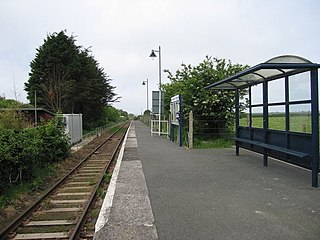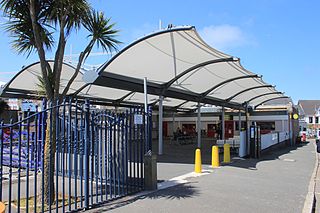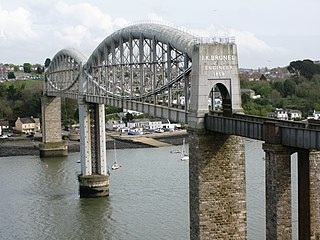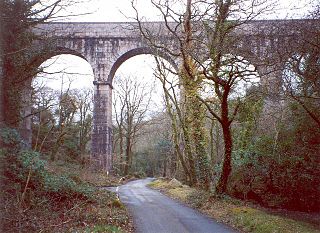See also
- Atlantic Coast Line, Cornwall
- West Cornwall Mineral Railways ISBN 978-1-904474-48-7 (February 2005) by Maurice Dart
| Overview | |
|---|---|
| Other name(s) | Toldish Tunnel |
| Location | Cornwall, England |
| Coordinates | East Portal: 50°24′14″N4°55′20″W / 50.4039°N 4.9223°W West Portal: 50°24′09″N4°55′43″W / 50.4025°N 4.9285°W |
| Status | Non active |
| Operation | |
| Opened | 1849 |
| Owner | Joseph Treffry |
| Operator | Treffry Tramways |
| Character | freight |
| Technical | |
| No. of tracks | single track |
| Track gauge | 1,435 mm (4 ft 8+1⁄2 in) (narrow gauge) |
Toldish Tunnel was built by Joseph Treffry as part of his mineral tramway from Newquay (Newquay to St. Dennis) which opened in 1849. This line was built to carry trams. In 1874 the line was taken over by the Cornwall Minerals Railway and the line from Newquay was extended to Par railway station. At this time the line from Newquay to Par was converted to standard gauge which was needed for the larger passenger carrying trains. It was not viable to widen the tunnel, so in 1874 it was bypassed and closed. [1] The new line missing out the Toldish tunnel section was opened on 1 June 1874.
The arch at the western entrance of the Toldish tunnel has been partially bricked up and the cutting is now flooded. [2] The tunnel is still shown as a disused railway [3] and runs east-west from grid reference SW 924601 to SW 920599. The eastern entrance is overgrown but looks to be in good condition. [4]

Newquay is a town on the north coast in Cornwall, in the south west of England. It is a civil parish, seaside resort, regional centre for aerospace industries, spaceport and a fishing port on the North Atlantic coast of Cornwall, approximately 12 miles (19 km) north of Truro and 20 miles (32 km) west of Bodmin.

The Lappa Valley Railway is a 15 in minimum gauge railway located near Newquay in Cornwall. The railway functions as a tourist attraction, running from Benny Halt to East Wheal Rose, where there is a leisure area with two miniature railways.

The Atlantic Coast Line is a 20+3⁄4-mile (33 km) Network Rail branch line which includes a community railway service in Cornwall, England. The line runs from the English Channel at Par, to the Atlantic Ocean at Newquay.

Par is a village and fishing port with a harbour on the south coast of Cornwall, England, United Kingdom. The village is situated in the civil parish of Tywardreath and Par, although West Par and the docks lie in the parish of St Blaise.

Luxulyan railway station serves the civil parish and village of Luxulyan in mid-Cornwall, England. The station is situated on the Atlantic Coast Line, 285 miles 78 chains measured from London Paddington. Great Western Railway manage the station and operates all the trains that call.

Par railway station serves the villages of Par, Tywardreath and St Blazey, Cornwall, England. The station is 282 miles (454 km) from London Paddington via Bristol Temple Meads. It is the junction for the Atlantic Coast Line to Newquay.
The Newquay and Cornwall Junction Railway was a 7 ft broad gauge railway intended to link the Cornwall Railway with the horse-worked Newquay Railway. It opened a short section to Nanpean in 1869, the remainder being built by the Cornwall Minerals Railway who took over the company in 1874. Its main traffic has always been china clay.

A passenger station was opened at Par on 20 June 1876 when the Cornwall Minerals Railway started a passenger service from Fowey to Newquay. It was adjacent to the railway's workshops. Although the station was built to serve Par, the entrance was on the west side of the town and close to the adjacent town of St Blazey.

Bugle railway station serves the village of Bugle in Cornwall, England. The station is situated on the Atlantic Coast Line, 288 miles 3 chains measured from London Paddington. All trains are operated by and the station is managed by Great Western Railway.

Roche railway station serves the village of Roche in Cornwall, England. The station is situated on the Atlantic Coast Line, 290 miles 40 chains measured from London Paddington. The station is managed and served by Great Western Railway local trains.

St Columb Road railway station serves the village of St Columb Road in Cornwall, England. The station is situated on the Atlantic Coast Line, 296 miles 11 chains measured from London Paddington. All services are operated by Great Western Railway, which also manages the station.

Quintrell Downs railway station serves the village of Quintrell Downs in Cornwall, England. It is 300 miles 16 chains measured from London Paddington, on the Atlantic Coast Line. The station is managed by Great Western Railway with local services in each direction all calling here.

Newquay railway station serves the town and seaside resort of Newquay in Cornwall, England. It is the terminus of the Atlantic Coast Line from Par, 302 miles 49 chains measured from London Paddington. The station is situated in the heart of Newquay, close to the town centre itself and the beaches. The station is managed by Great Western Railway which operates local branch line services to and from Par. In the summer, there are also services to and from London.
St Dennis Junction was in St Dennis, Cornwall.

Nanpean is a village in the civil parish of St Stephen-in-Brannel in Cornwall, United Kingdom. The B3279 road runs through the village which is approximately 4 miles (6.4 km) north-west of St Austell in the heart of 'clay country', the china clay mining area of mid-Cornwall.

The Treffry Viaduct is a historic dual-purpose railway viaduct and aqueduct located close to the village of Luxulyan, Cornwall in the United Kingdom. The viaduct crosses the Luxulyan Valley, and with it forms an integral part of the Cornwall and West Devon Mining Landscape, a World Heritage Site. It is scheduled under the Ancient Monuments and Archaeological Areas Act 1979 and due to its poor condition is on Historic England's, Heritage at Risk Register.

The Cornish Main Line is a railway line in Cornwall and Devon in the United Kingdom. It runs from Penzance to Plymouth, crossing from Cornwall into Devon over the famous Royal Albert Bridge at Saltash.

The Cornwall Minerals Railway owned and operated a network of 45 miles (72 km) of standard gauge railway lines in central Cornwall, England, United Kingdom. It started by taking over an obsolescent horse-operated tramway in 1862, and it improved and extended it, connecting Newquay and Par Harbours, and Fowey. Having expended considerable capital, it was hurt by a collapse in mineral extraction due to a slump in prices. Despite its title, it operated a passenger service between Newquay and Fowey.

The Treffry Tramways were a group of mineral tramways in Cornwall in the United Kingdom, constructed by Joseph Treffry (1782-1850), a local land owner and entrepreneur. They were constructed to give transport facilities to several mines and pits producing non-ferrous metal, granite and china clay in the area between the Luxulyan Valley and Newquay, and were horse-operated, with the use of water and steam power on inclines, and at first operated in conjunction with the Par Canal and Par Docks, also constructed by Treffry. One of the routes crossed the Luxulyan Valley on a large viaduct, the largest in Cornwall when it was built.
The Truro and Newquay Railway was a Great Western Railway line in Cornwall, United Kingdom designed to keep the rival London and South Western Railway (LSWR) out of the west of the county. The line was completed in 1905 and closed in 1963.